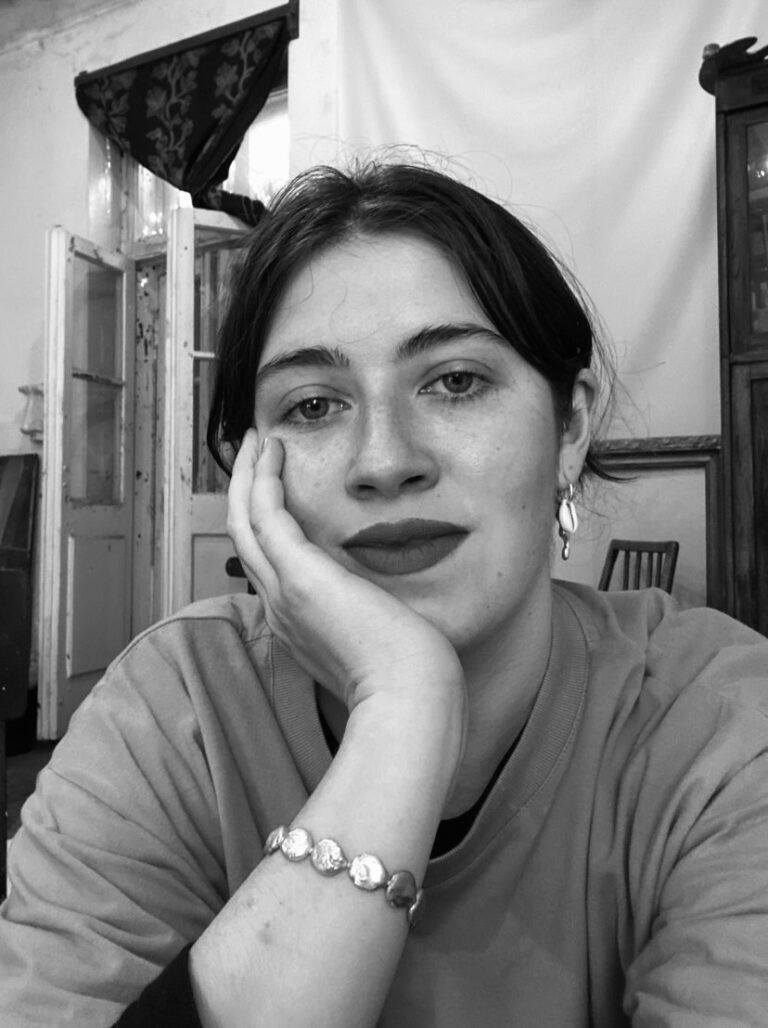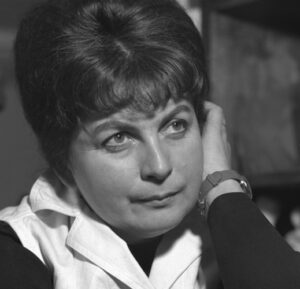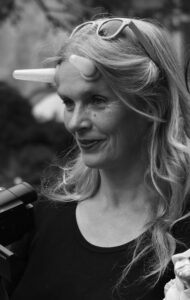Kateryna Aliinyk / Катерина Алійник

— born in 1998 in Luhansk, Ukraine. Since 2016, she has lived and worked in Kyiv. In 2021 she got her master’s degree in art from the National Academy Of Fine Arts And Architecture in Kyiv. In 2020 she completed a course in contemporary art in the Kyiv Academy of Media Arts and Methodfund’s contemporary arts course «Positions of the Artists». Her main mediums are painting and text. Kateryna mainly works with the topic of the landscape that was damaged from the war and occupation. She works through the images of nature and non-anthropocentric optics.
Almost everything I do can be perceived as love letters to the Ukrainian Donbas.
Because war has been shaping me since such a young and innocent age, my practice shows how I see myself, my life, my desires, hopes, and plans through these events. I can fully grasp this reality with my mind through painting and writing.
War and the observation of nature are the most sensual, voluminous, and long-lasting experiences of my life, and so they are combined in my practice. My relationship with the landscape, well known from childhood, has always seemed unbreakable, unlike my relationships with people. But the war showed me that it can’t be stable either.
The inability to get closer to the landscape and interact with it turned into a realization of its greatness and a deep sense of respect. It turned out that my presence was powerless to influence the faith of this land, and my absence was just my personal tragedy. That is when I realized that landscape isn’t a background; it’s an action. My artistic practice began with a shift in the meaning of these concepts.
All of my artworks are, in one way or another, dedicated to the Ukrainian Donbas – the pre-war Donbas and the way they have become. Still, they are also dedicated to something eternal, something that exists beyond war. Sometimes, all of these dimensions are present in one artwork as a distortion of scale, space deformation, and inconsistent plans.
I started with the series of artworks, Medical and Political Fantasy about Luhansk in 2021, about life and agriculture in people’s private plots of land in occupied territories. Non-existent or mutated root vegetables look like grenades or body parts and organs as if that is the way they grew from the soil that has been soaked in the fluids of war. When creating these artworks, I couldn’t visit Luhansk for a couple of years because of my new Kyiv residency, and I could only fantasize about what was happening on the other side of the “border.” This series revealed the hidden transformations caused by slow, long-term violence.
After the start of the Russian full-scale invasion, land in a section started appearing in my artworks, with layers of cruelty constantly accumulating on these lands. That is why it’s scary to look at the landscape. But then my gaze came out from under the ground; I started looking at it at an angle and perpendicularly from above (the Double Harvest work). At first glance, you would think that the landscape cannot preserve the traces of tragedy for a long time, but a closer look reveals them and how they co-exist with a peaceful life.
This was followed by the series We’ve Got the Front-Row Tickets, with more of a conventional view of a landscape, where we look at it from far away and can’t see everything through the green bushes, but the tension remains. There are many things we can only look at from a certain distance, which we can’t influence but can’t look away. There are almost no human traces left here. The longer you motionlessly stand in front of the landscape, the more you can feel its impenetrable density and the greatness of its long-term abandonment, which you don’t dare to interfere with.
The process of painting for me is like a walk and an adventure where I’m paying close attention to the details and later assemble them into a plot. Just with the brush stroke or a word, I am able to touch these places, to caress them even the way they are now. Once I return there, my heart will explode from the excessive feelings.
There is a big stigmatization put on my native land, my native language, and many other things related to my past. So, instead of being sentimental, I chose another approach – treating horror with tenderness. Horror has been around for such a long time and has affected most aspects of my life that my relationship with it has become different and more complicated. But it isn’t acceptance; it’s coexistence.
I like acrylic paint because it’s a synthetic material, which already indicates a certain inorganicity in a landscape, something alien. Its fluidity and slight uncontrollability resemble nature itself, which is full of fluids. I am using bright colors because even during the war, the sky remains blue, and the grass isn’t any less green.
My artworks should make viewers feel before they make them think. The feeling overcomes the incompatibility of different human spaces and distances. The variety of points of view in my paintings and how they are presented makes you stay in front of them for a longer time and look closely.
The text was written in a collaboration with Oksana Briukhovetska (2024).
1Image: Kateryna Aliinyk, What the heroine wants is the main question, acrylic, paper, 2023. Courtesy of the artist.2Image: Kateryna Aliinyk, Is it edible?, acrylic, canvas, 2022. Courtesy of the artist.
3Image: Kateryna Aliinyk, Tomb Sticks, acrylic, canvas, 2023. Courtesy of the artist.
4Image: Kateryna Aliinyk, Medical and Political Fantasy about Luhansk, acrylic, paper, 2021. Courtesy of the artist.
5Image: Kateryna Aliinyk, Medical and Political Fantasy about Luhansk, acrylic, paper, 2021. Courtesy of the artist.
6Image: Kateryna Aliinyk, We got front-row tickets, acrylic, paper, 2023. Courtesy of the artist.
7Image: Kateryna Aliinyk, Slow Plot Development, acrylic, paper, 2023. Courtesy of the artist.
8Image: Kateryna Aliinyk, Ukrainian Garden, acrylic, canvas, 2022. Courtesy of the artist.
9Image: Kateryna Aliinyk, Neglected Part of the Garden, acrylic, canvas, 2022. Courtesy of the artist.
10Image: Kateryna Aliinyk, Double Cropland, acrylic, canvas, 2022. Courtesy of the artist.

— народилася 1998 року в Луганську, Україна. З 2016 живе та працює в Києві. У 2021 році отримала ступінь магістра живопису в НАОМА. У 2020 році закінчила курс у КАМА за спеціальністю “Сучасне мистецтво” та курс сучасного мистецтва Методфонд «Позиції художни_ць». Основні медіуми – живопис і текст. Працює переважно з темою пейзажу, що постраждав від війни та окупації. Працює через образи природи та не-антропоцентричну оптику.
Майже все що я роблю – це любовні листи Українському Донбасу.
Через те, що війна формує мене з такого юного та ніжного віку, моя практика відображає те, як крізь ці події я бачу себе, своє життя, бажання, надії і плани. Охопити цю реальність своїм розумом можу саме через живопис і текст.
Війна і споглядання природи – найбільш чуттєві, об’ємні й тривалі переживання в моєму житті, і вони поєднались у моїй практиці. Стосунки зі знайомим з дитинства пейзажем здаються непорушними, на відміну від стосунків з людьми. Війна показала, що й вони не стабільні.
Неможливість наблизитись до пейзажу і взаємодіяти з ним перетворилась в узріння його величі та глибоке почуття поваги. Виявилося, що моя присутність безсила вплинути на долю цього краю, а моя відсутність – лише особиста трагедія. Тоді я збагнула, що пейзаж – це не тло, а, власне, дія. З цього зсуву значень і почалася моя художня практика.
Усі мої роботи так чи інакше присвячені українському Донбасу – довоєнному, тому, яким він став, але також чомусь вічному, що існує поза війною. Іноді усі ці виміри присутні в одній роботі у вигляді збою в масштабі, викривлення простору, непослідовності планів.
Я почала з серії Медична і політична фантазія про Луганськ у 2021 про життя і землеробство на приватних ділянках в окупованих територіях. Неіснуючі або мутовані коренеплоди, які нагадують гранати, частини тіла чи органи, наче виросли такими в грунті, просотаному рідинами війни. На той момент я вже кілька років не могла відвідувати Луганськ через київську прописку і могла тільки фантазувати про те, що відбувається по той бік ʼʼкордонуʼʼ. У цій серії оприявились приховані трансформації, спричинені повільним насиллям.
Після початку повномасштабного вторгнення в моїх роботах з’явилася земля в розрізі, з уявою про шари жорстокості, що невпинно накопичується на цих землях. Тому на пейзаж дивитися страшно. Потім мій погляд вийшов з-під землі, я стала дивитися на неї під кутом, а згодом перпендикулярно зверху (робота Подвійний врожай). На перший погляд пейзаж довго не зберігає сліди трагедії, але наближений погляд виявляє їх і те, як вони співіснують з мирним життям.
Після цього з’явилася серія У нас квитки у перший рядʼ з більш конвенційним поглядом на пейзаж, де ми дивимося здалеку і не можемо всього розгледіти за зеленими кущами, але напруга лишається. Багато на що ми можемо дивитись тільки з певної відстані, не можемо вплинути, але й відвести очі теж. Тут вже навіть слідів людини майже немає. Чим довше нерухомо стоїш перед краєвидом, то виразніше відчуваєш його непроникну щільність, велич довготривалої занедбаності, в яку не наважуєшся втручатися.
Процес живопису для мене – це прогулянка і пригода, у якій я приглядаюсь до деталей, які потім збираю в сюжет. Лише мазком пензля чи словом мені вдається доторкнутися до цих місць, приголубити їх навіть такими, якими вони є тепер. Здається, що коли я повернусь туди, моє серце не витримає надмірних почуттів.
На мої рідні краї, мою рідну мову і багато чого іншого, пов’язаного з моїм минулим, накладено сильну негативність, тому замість сентиментальності я виробила інший підхід – ставлення до жаху з ніжністю. Жах настільки довго вже поруч і торкнувся більшості сфер мого життя, що і стосунки з ним стали іншими, складнішими. Але це не примирення, а співіснування.
Мені подобається акрил через те, що це синтетичний матеріал, що вже вказує на якусь неорганічність в пейзажі, на щось чужорідне. А його флюїдність і легка безконтрольність нагадує саму природу, в якій багато рідин. Я використовую яскраві кольори, бо навіть під час війни небеса не перестають бути блакитними, а трава менш зеленою.
Мої роботи мають викликати відчуття, і воно має передувати думці. Відчуття долає неспівмірність різних людських просторів і відстаней. Різноманіття кутів зору в моїх картинах і спосіб, у який вони написані, спонукає довше постояти перед ними і уважно подивитися.
Текст написаний у співпраці з Оксаною Брюховецькою (2024).
1Зображення: Катерина Алійник, Чого хоче героїня-головне питання, aкрил, папір, 2023. Надано художницею.2Зображення: Катерина Алійник, Чи це їстівне?, aкрил, полотно, 2022. Надано художницею.
3Зображення: Катерина Алійник, Надгробні палиці, aкрил, полотно, 2023. Надано художницею.
4Зображення: Катерина Алійник, Медична й політична фантазія про Луганськ, aкрил, папір, 2021. Надано художницею.
5Зображення: Катерина Алійник, Медична й політична фантазія про Луганськ, aкрил, папір, 2021. Надано художницею.
6Зображення: Катерина Алійник, У нас квитки в перший ряд, aкрил, папір, 2023. Надано художницею.
7Зображення: Катерина Алійник, Повільний розвиток сюжету, aкрил, папір, 2023. Надано художницею.
8Зображення: Катерина Алійник, Український сад, aкрил, полотно, 2022. Надано художницею.
9Зображення: Катерина Алійник, Закинута частина саду, aкрил, полотно. 2022. Надано художницею.
10Зображення: Катерина Алійник, Подвійний врожай, aкрил, полотно, 2022. Надано художницею.

